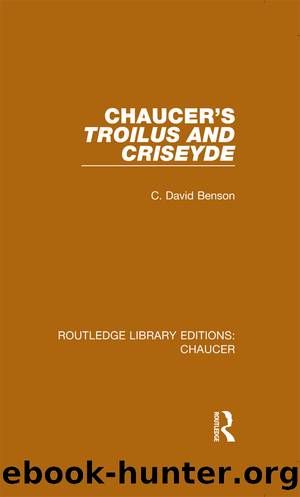Chaucer's Troilus and Criseyde by C. David Benson;

Author:C. David Benson;
Language: eng
Format: epub
Publisher: Taylor & Francis (CAM)
Published: 1990-01-15T00:00:00+00:00
Coda: The Narrator
The narrator, a figure who has often been considered a fourth major character in Troilus and Criseyde, must also be discussed, however briefly, in this chapter, if only to show that he does not really belong. Although his many comments on the action provide some justification for linking him with Troilus, Criseyde and Pandarus, he never becomes a fully developed, independent human character. He plays no part in the action itself, despite his emotional involvement, and it is often impossible to distinguish his statements from those of the poet. The narrator in Troilus is better seen as a flexible literary voice than as a human personality - a rhetorical element of the text that Chaucer uses to create a number of different effects. The most important function of this voice may be to reveal the silences and uncertainties of the poem and thus encourage the interpretive role of each reader.
Despite the autobiographical claims of Boccaccioâs Filostrato, its narrative unfolds with remarkable objectivity, as discussed in chapter 2. Not so Troilus and Criseyde, to which Chaucer has added an intricate layer of narrative commentary. Substantial invocations precede each book except the last, and the reader is frequently addressed in casual asides: after a familiar proverb, for instance (âThis, trowe I, knoweth al this compaignyeâ, 1.450), or to mark a change of scene (âNow lat hire siepe, and we oure tales holde/Of Troilusâ¦â, II.932â3). We are also frequently told about the process of composition: the narrator discusses his source (a certain Lollius), announces his approach (the love-story rather than the war), admits gaps in his information (even when, as in respect to Criseydeâs children, Filostrato is perfectly clear) and justifies his abridgements. Even more striking are direct expressions of enthusiasm about the progress of the narrative and of the love-affair. The narrator urges on Pandarusâ first visit to Criseyde (âNow Janus, god of entree, thow hym gyde!â, 11.77) and wishes he had experienced such a night of amatory joy (âWhy nad I swich oon with my soule yboughtâ, III.1319). Criseyde is an object of special concern; to choose two famous examples among many, the narrator defends her against possible accusations of falling in love too quickly (II.666â79) and is sympathetic even after her betrayal (V.1093â9).
For a long time, when they thought about it at all, critics assumed that such first-person comment, some of which is obviously comic, was in the poetâs own voice. Donaldson seems to have been the first to treat the Chaucerian narrator as a separate character. In an influential study of the Canterbury Tales (âChaucer the Pilgrimâ), he argued that the portraits in the General Prologue were drawn not by the poet himself but by an independent persona, who was enthusiastic, naïve, and not wholly to be trusted. In subsequent articles and in his edition of Chaucer, Donaldson posited an equally independent and unreliable narrator for Troilus and Criseyde, whose sentimental opinions, especially in defence of Criseyde, we are meant to question. In order to make this
Download
This site does not store any files on its server. We only index and link to content provided by other sites. Please contact the content providers to delete copyright contents if any and email us, we'll remove relevant links or contents immediately.
The Power of Myth by Joseph Campbell & Bill Moyers(925)
Half Moon Bay by Jonathan Kellerman & Jesse Kellerman(911)
A Social History of the Media by Peter Burke & Peter Burke(879)
Inseparable by Emma Donoghue(844)
The Nets of Modernism: Henry James, Virginia Woolf, James Joyce, and Sigmund Freud by Maud Ellmann(738)
The Spike by Mark Humphries;(719)
A Theory of Narrative Drawing by Simon Grennan(706)
The Complete Correspondence 1928-1940 by Theodor W. Adorno & Walter Benjamin(703)
Ideology by Eagleton Terry;(657)
Bodies from the Library 3 by Tony Medawar(648)
Culture by Terry Eagleton(646)
World Philology by(645)
Farnsworth's Classical English Rhetoric by Ward Farnsworth(641)
A Reader’s Companion to J. D. Salinger’s The Catcher in the Rye by Peter Beidler(614)
Adam Smith by Jonathan Conlin(606)
Game of Thrones and Philosophy by William Irwin(592)
High Albania by M. Edith Durham(589)
Comic Genius: Portraits of Funny People by(581)
Monkey King by Wu Cheng'en(575)
